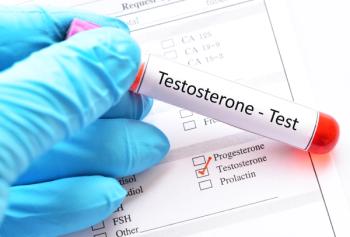
- Psychiatric Times Vol 26 No 8
- Volume 26
- Issue 8
DisFigured: The Making of a Movie
I wrote, directed, coedited, and financed DisFigured because it’s a movie I wanted to see. I’m not a woman and I don’t have an eating disorder, but the issues of appearance, control, isolation, and our complicated relationships with our bodies seem universal to me. They are also sadly underexplored or horribly twisted in almost every form of media. I am particularly aware of this because my wife Jenn is beautiful, graceful, stylish and-according to popular culture-fat.
Director’s Statement
I wrote, directed, coedited, and financed DisFigured because it’s a movie I wanted to see. I’m not a woman and I don’t have an eating disorder, but the issues of appearance, control, isolation, and our complicated relationships with our bodies seem universal to me. They are also sadly underexplored or horribly twisted in almost every form of media. I am particularly aware of this because my wife Jenn is beautiful, graceful, stylish and-according to popular culture-fat.
I have seen her ashamed to go to an exercise class at a size 22, accepted among dancers at a size 16, and rejected by salespeople in boutiques at a size 12. I have seen her proud, angry, hurt, confident, and confused. But, honestly-it’s not as if this stuff is hard to know about. Is there anyone in America with no firsthand knowledge of people struggling on all sides of these questions? And they are questions.
Some situations are complex and can’t be solved. Those are the things we should make movies about. Easy answers don’t really need a movie. I truly love being a “Hollywood screenwriter” and I’ll never stop escaping into melodrama and fantasy, but sometimes you tell stories in order to explore the messy truths of our daily experience. And, because we are living in marvelous times, anyone can make a movie.
A Behind the Scenes Look at Making the Movie
We shot the movie in 15 days with a total of 6 to 8 crew members. No trucks, no trailers, no generators, no dollies. The rule was: if it couldn’t fit in a car and be carried by the crew, we couldn’t use it. Cinematographer (and “A” camera operator) Idit Dvir shot it with 2 Canon XL2 standard-definition miniDV cameras, mostly with just natural light or “china balls.” Production sound mixer Brandi Rice operated the entire sound department out of a folding shopping cart.
While this approach helps make the movie feel as truthful as possible, it was not motivated by a Dogma-like philosophical stringency. There was simply no other way to convince people to let us rent their locations. Everyone in Los Angeles knows a film crew brings with it 3 things: damage, parking problems, and cash. Since we had almost none of the last one, we had to go a long way to defuse the threat of the first 2. To make things less stressful on the cast and crew, I tried to avoid shooting at night. Therefore, we taped heavy black plastic over all the doors and windows of the un–airconditioned guest cottage we were using as Lydia’s house. Unfortunately, those shooting days turned out to be among the hottest in Los Angeles history, so my “EZ day–for–nights” completely cooked the very people I was trying to protect. You try, you learn.
It’s difficult to find a crew for a “no–budget” shoot, especially since I disqualified more than half of the available work force: I wanted only women on the set. Mostly, I wanted to give the actors the most comfortable and supportive set I could manage. They were going to be exposing themselves-physically and emotionally, and I didn’t want a bunch of guys standing around off–camera passing judgment on the actors’ bodies and their feelings. Once we started shooting, it was clear we needed a production assistant. Line producer Laura Boersma brought in Anthony Fultz, pointing out, “We can’t discriminate against him just because he’s a guy.”
I didn’t want name actors-and very few would have been interested since our budget allowed only $100 a day for key characters. Executive producer David Higgins brought the script to casting agent Valerie McCaffrey, who got it out to actors and agents. We spent much of a year flirting with “names” and collecting everyone else’s head–shots. But in the end, the characters found the actors: both Staci Lawrence and Ryan C. Benson were brought in by actor friends who read the script to audition for other roles and felt (correctly) they would be perfect for “Darcy” and “Bob.”
Ryan was actually more handsome and less heavy than I intended “Bob” to be, but watching Ryan’s audition I realized he would bring a wonderful complexity and ambivalence to our feelings about “Bob.” Meanwhile, Deidra Edwards read the script very early on and sent me a passionate, insightful note about “Lydia.” She waited for more than a year to audition. Ironically, her determination and instant connection with the role worked against Deidra: I made her come back for more call–backs than anyone else, partly because you can’t take the first person who reads and also because I was worried that knowing how much she wanted it was skewing my perception.
Staci, on the other hand, got a lucky break because I had to run the camcorder during some auditions. Distracted by wearing a lot of hats, I pushed the “stop/start” button too many times: I turned it off at the start of a scene she was reading, and then, thinking I was turning it off at the end, started recording. I was then called out of the room for a few minutes, so Staci sat waiting alone, unaware the camera was running. Her audition was great-but it was all “audition energy.” The solitary unguarded minutes on the tape showed me the side to her that I needed to see to confirm she could be “Darcy.”
DisFigured was filmed entirely within a 2–mile radius of Venice Beach. A movie needs a sense of place. I particularly wanted to show Venice Beach “as is.” Bikini–clad–rollerbladers on the bike path are certainly a part of the scene, but I also wanted to get the fog, the cleaning crews, the homeless. And since we did not have the crew to lock up exterior locations, anyone you see wandering in the background is a real person.
Lydia’s house, however, is very much a creation of production designer Tabitha Johnson. We shot there for only 3 days, but it took 3 weeks to get it ready. Borrowing, scrounging and begging items from artists, thrift shops, prop houses, my office, and my wife’s dresser, Tabitha redecorated a converted garage to express Lydia’s colorful, contrary personality.
She had to work in the opposite direction for Darcy’s condo. She removed art from the funky home we rented and replaced it with restrained canvases that she and her assistants painted. But Tabitha also added those great sunflowers to remind us there’s more in Darcy, waiting to bloom.
We shot the Fat Acceptance Group meetings on the second and third days of our schedule. I figured we might as well jump in the deep end: the crew had to capture 14 people improvising, and the actors had to talk about their bodies and sexuality in front of a room full of strangers and 2 cameras. While it may seem like they are simply spilling their souls-the fact is, some moments are entirely “in character” and not what the actors personally believe in or have experienced. I had asked them to discuss specific questions, and take certain stands, I then let the cameras run for 10 minutes. Yet we also all felt during those 2 days of filming that the actors were tapping into something real. There is a unique power in talking honestly. That’s what the movie is about.
Articles in this issue
over 16 years ago
Reality-Checking: Case in Pointover 16 years ago
A Response to the Charge of Financial Motivationover 16 years ago
From Chaos to Consilience: Part IIIover 16 years ago
Marketing Off-Label Uses: Shady Practices Within a Gray Marketover 16 years ago
The Great DSM Debateover 16 years ago
Borderline Personality Disorder and Resistance to Treatmentover 16 years ago
Chronic Eating Disordersover 16 years ago
Introduction Underlying Causes and ImplicationsNewsletter
Receive trusted psychiatric news, expert analysis, and clinical insights — subscribe today to support your practice and your patients.

















